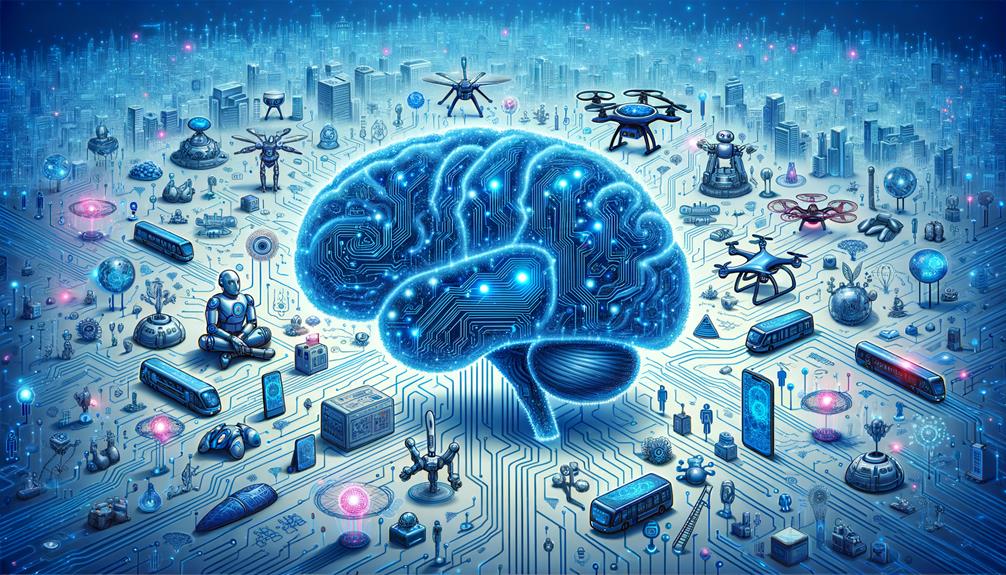

You're about to enter the fascinating world of artificial intelligence[1], where machines learn, reason, and problem-solve like humans. AI is a branch of computer science that utilizes algorithms and large datasets to identify patterns and make predictions through machine learning techniques. As you explore this field, you'll encounter different types of AI, such as Narrow AI and General AI, each designed for specific tasks or more general cognitive abilities. Your journey is just beginning – with the rapid evolution of AI, there's more to discover about its potential to transform industries, its limitations, and the roles it can play in daily life.
When you hear the term Artificial Intelligence (AI), you're likely referring to a branch of computer science that creates intelligent systems capable of performing tasks that would typically require human-like intelligence. This field, coined by John McCarthy in 1956, focuses on building systems that can learn, reason, and problem-solve like humans.
AI utilizes algorithms and vast amounts of data to identify patterns, make predictions, and improve its performance through machine learning techniques. You'll encounter AI in various applications, including Narrow AI designed for specific tasks, while General AI remains a theoretical goal.
As AI continues to advance, you'll see it transform industries like healthcare, finance, and customer service. However, despite its progress, AI still has limitations, particularly in understanding general intelligence and common sense.
You'll encounter several types of AI, each with distinct capabilities and applications, which can be categorized based on their functionalities and objectives. Let's break down the main types:
Narrow AI: Designed for specific tasks, like voice recognition in virtual assistants, it excels in defined functions without broader cognitive abilities.
General AI: Aims to replicate human-like cognitive abilities across various tasks, but remains largely theoretical.
Super Intelligent AI: A hypothetical form of AI that would exceed human intelligence and problem-solving abilities, potentially addressing major global challenges.
Machine Learning and Deep Learning are key components of AI applications, enabling systems to learn from data and improve over time through supervised, unsupervised, and reinforcement learning.
Natural Language Processing is another vital aspect of AI, allowing systems to understand and interact with humans effectively.
AI's ability to absorb and apply knowledge is rooted in machine learning, a subset of artificial intelligence that enables systems to learn from data and improve their performance over time.
You see, machine learning uses algorithms to identify patterns in large datasets, making predictions without explicit programming.
There are several key methods, including supervised learning, where labeled data teaches AI systems to classify information accurately.
Unsupervised learning analyzes and clusters unlabeled data, while reinforcement learning rewards AI for correct actions, improving decision-making over time.
Deep learning employs neural networks with multiple layers to process complex data, enhancing AI's capabilities in tasks like speech and image recognition.
Building on its ability to learn and adapt, AI is now being applied in various industries, transforming the way we live and work with its impressive capabilities in areas such as healthcare, finance, and transportation.
You're probably already using AI in your daily life, whether it's through virtual assistants like Siri or Alexa, or when you use online banking and transaction services that rely on machine learning for fraud detection.
Here are just a few examples of how AI applications are making a difference:
As AI applications become increasingly integrated into various aspects of life, mitigating the risks and addressing the ethical concerns associated with its development and deployment have become critical priorities.
You need to be aware of the potential biases that AI can perpetuate, which can lead to skewed results and reinforce societal inequalities. Ensuring accountability, fairness, and the protection of human rights is essential, particularly as AI capabilities expand.
Automation also raises concerns about job displacement, while model drift highlights the need for continuous updates to maintain accuracy.
To navigate these risks, you must prioritize transparency, rigorous testing, and ongoing evaluation. By doing so, you can harness the power of AI while minimizing its potential negative impacts.
To access the full potential of artificial intelligence while minimizing its risks, you must prioritize responsible AI use by establishing and adhering to rigorous guidelines and principles. This involves creating ethical frameworks that guarantee transparency, accountability, and fairness in AI decision-making processes.
You'll need to address potential biases in training data that can lead to skewed outcomes. Here are some key considerations:
From healthcare and finance to customer service and transportation, you're likely interacting with artificial intelligence in various aspects of your daily life, often without even realizing it.
In healthcare, AI applications are enhancing diagnostic accuracy and creating personalized treatment plans through machine learning.
You're also benefiting from AI in customer service, where chatbots provide 24/7 support.
Additionally, autonomous vehicles are utilizing computer vision and machine learning to navigate safely.
In finance, AI systems are detecting fraud and reducing operational costs.
Generative AI tools are even transforming creative fields like art and music.
These AI applications are revolutionizing industries and making your life easier.
As AI technology advances, you can expect to see even more innovative applications in the future.
Increasingly, you'll see artificial intelligence transforming every aspect of your life, with significant advancements in human-like reasoning and personalized services on the horizon.
As AI technologies evolve, they'll play a critical role in automating processes across various industries, potentially enhancing productivity and creating new job opportunities.
Here are some ways AI will impact your life:
As the future of artificial intelligence unfolds, you'll see vast improvements in your daily life.
You can start learning AI by taking online courses, diving into hands-on projects, and mastering programming languages like Python. Explore AI tools, community forums, and tutorials to build a strong foundation and avoid common beginner mistakes.
You're about to immerse yourself in AI, exploring its basics, including machine learning, neural networks, and data science. You'll discover applications like natural language, computer vision, and robotics, while considering ethical implications and the impact of automation.
You're among 70% of professionals learning AI on their own! With abundant self-study resources, online courses, and practical projects, you can master AI concepts. Set personal goals, explore tools like TensorFlow, and engage with community forums for success.
You'll explain AI to a layman by simplifying concepts like machine learning, neural networks, and data processing, and using relatable examples like natural language, computer vision, and robotics applications, while also discussing ethical considerations and automation benefits.
